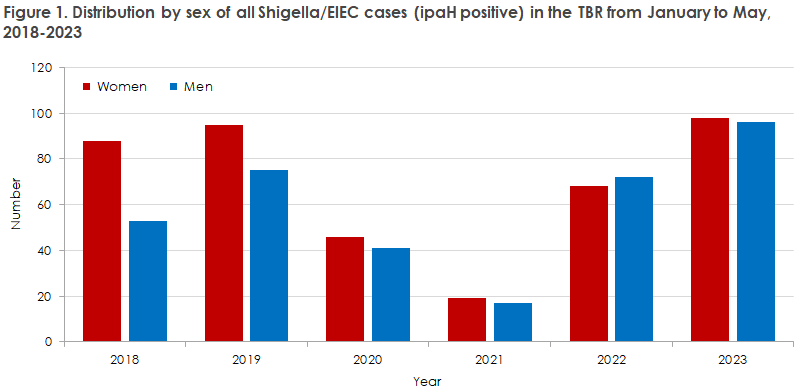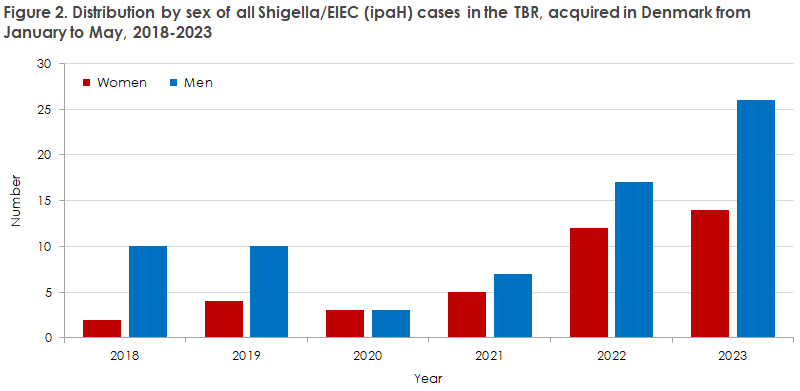No 26a - 2023
Shigella in men who have sex in men - transmission in Denmark and antibiotic resistance occurs
Shigella in men who have sex in men - transmission in Denmark and antibiotic resistance occurs
Shigella is a bacterium that causes diarrhoea and which is primarily associated with food- and water-borne transmission and travels abroad. The bacterium occasionally causes outbreaks in Denmark, e.g., in connection with imported vegetables EPI-NEWS 41/2020. It is, however, well described internationally that Shigella is also a sexually transmitted disease, particularly among men who have sex with men. This is also the case in Denmark, where there are currently cases of Shigella with resistance towards ciprofloxacin, azithromycin, trimethoprim with sulfamethoxazole, ampicillin, and ceftriaxone among individuals in this group- this is known as extensively drug resistant (XDR) Shigella.
Patients and physicians alike therefore need to show attentiveness to the risk of sexual transmission of Shigella in men who have sex with men, including Shigella types for which the treatment options are limited. Clinicians who treat patients with Shigella infections should be aware of the risk of antibiotic resistance when choosing an empirical antibiotic. This applies to Shigella cases who have become infected abroad and also to cases in men who have sex with men whether they were infected in Denmark or abroad.
What is Shigella?
Shigella is a gram-negative rod-shaped bacterium, which is related to E.coli. Shigella shares similarities with enteroinvasive E. coli (EIEC) as both are positive for the ipaH gene. The Shigella genus comprises four species: S. dysenteriae, S. flexneri, S. boydii and S. sonnei, which can be divided into various serotypes.
Infection with Shigella causes gastroenteritis, lasting a number of days, and the infection is often self-limiting. Shigella dysenteriae of type 1 is the classic cause of severe blood- and pus-containing diarrhoea symptoms (bacterial dysentery). However, severe, treatment-requiring diarrhoeal disease may also be caused by other Shigella types. The first-choice treatment is orally administered ciprofloxacin or azithromycin. As an alternative, and in case of resistance to these drugs, ceftriaxone may be used.
How to avoid becoming infected with Shigella?
The only host of the Shigella bacterium is humans. The bacterium is excreted in and transmitted via faeces. The infectious dose is low, but good hygiene conditions and correct/adequate heat treatment of foods can prevent food-borne transmission. Faecal-oral transmission may also occur during sex; directly via anal or oral sex, but also indirectly via sex toys, condoms, etc.
To avoid sexual transmission of Shigella, we recommend the following: use a condom/dental dams during intercourse, wash your hands, genitals and anus with water and soap before and after sexual contact, and clean any sex toys. If you have been diagnosed with Shigella, we recommend avoiding sex for a minimum of two weeks counted from the last day with diarrhoea.
Shigella sonnei with widespread resistance
From March to May 2023, a total of 107 Shigella/EIEC cases were identified, of which 26 were reported as acquired in Denmark. Shigella sonnei with extensive phenotypic resistance, including resistance to ceftriaxone, was detected in 10 cases, Table 1.

The ten cases were identified at four different departments of clinical microbiology (DCMs) in three different Danish regions. Nine had no travel history and several were reported as having become infected in Denmark. All ten cases were men, and several of the patients stated in a phone interview that they have sex with men. Whole-genome sequencing of Shigella bacteria that could be cultured showed that seven of the ten cases belonged to two different genetic clusters.
Shigella/EIEC cases among men in Denmark
Shigella is both clinically and laboratory notifiable in Denmark. All laboratory notifications are recorded in the Danish register of Enteropathogenic bacteria (TBR). According to the TBR data for 2023, there is an equal distribution of cases between men and women with confirmed Shigella/EIEC infections, similar to the pattern observed in the three preceding years. However, this distribution is different from the situation before the COVID-19 pandemic (in 2019 and 2018), where women were more commonly affected, as shown in figure 1.

In the first five months of 2023, a total of 65% (n = 26) of the patients notified as having become infected with Shigella/EIEC in Denmark were men, Figure 2. Correspondingly, men comprised the main share of Danish-acquired cases in the same period of 2018, 2019, 2021 and 2022, whereas the sex distribution was equal during the COVID-19 pandemic in 2020.

The departments of clinical microbiology attempt to culture Shigella, which enables them to determine any antibiotic resistance. However, culturing is not always successful as Shigella bacteria are fragile and may die due to previous antibiotics treatment or during transport of fecal samples to the laboratory. Consequently, clinicians may not receive resistance determinations for all cases. In such situations, treatment decisions must rely on clinical judgment. Simultaneously, there may be a significant number of XDR Shigella infections in Denmark that go unrecognized.
(T.G. Larsen, S. Nielsen, Department of Infectious Disease Epidemiology and Prevention, M. Torpdahl, S. Schjørring, Department of Bacteria, Parasites and Fungi, J. Engberg, DCM Køge, B. Olesen, DCM Herlev, M. Rubin, E. Björklund, DCM Hvidovre)
Listeria trends and monitoring in Denmark, 2019-2022
Invasive listeriosis is a rare but serious food-borne infection caused by the bacterium Listeria monocytogenes. The infection mainly affects persons whose immune system is weakened due to diseases, advanced age, or pregnancy. Due to its severity and outbreak potential, Statens Serum Institut (SSI) performs whole-genome sequencing on all listeria isolates from invasive infections to identify genetic clusters/outbreaks. SSI also interviews, to the extent possible, all patients in order to map exposures in the month before they presented with symptoms.
An epidemiological report on listeriosis in Denmark in the 2019-2022 period is now available at the SSI website.
During the period 2019-2022, an average of 63 cases [range: 43-86] was registered annually. Of these cases, 16% were identified in spinal fluid or notified as purulent meningitis, and an additional 80% were identified by blood sampling. A total of 11 cases occurred in pregnant women or their unborn/newly born child. A total of 75% of the patients were more than 65 years old and cases were observed in all provinces of Denmark. In the period 2019-2022, 60% of patients had a listeria type that had been observed in at least one other patient since 2014, indicating that the patients were part of a genetic cluster. Therefore, continued collaboration with clinical microbiological departments for the prompt submission of isolates, as well as with hospital departments and patients for obtaining useful information about food intake, is extremely important and valuable for early identification and investigation of disease outbreaks.
In 2022, a significantly higher number of listeria cases (86) were observed compared to the usual. About one-third of the listeria cases in 2022 were attributed to three different outbreaks. The sources of two of these outbreaks were identified and eliminated: spiced sliced meat rolls and fish cakes. Other major outbreaks in the 2019-2022 period were caused by smoked fish products and water-containing products from a greengrocer. These outbreaks are described in more detail in the Danish listeriosis report covering the 2019-2022 period.
The SSI collaborates closely with the Danish Veterinary and Food Administration and DTU Food under the auspices of the Central Outbreak Group to solve outbreaks and avoid more people from becoming infected by the same food item.
L. monocytogenes is present everywhere in the environment and therefore also in many raw or lightly processed foods. L. monocytogenes grows at fridge temperature and risk foods are typically ready-to-eat foods with a long shelf life at fridge temperature. Known risk products include cold meat cuts, sliced fish products, e.g., cold-smoked and raw-spiced fish, as well as soft cheeses, particularly those made from unpasteurised milk. The Danish Veterinary and Food Administration has issued guidelines to avoid listeriosis during pregnancy, or in case of serious illness or immunodeficiency.
(L. Espenhain, P. Kold Munch, L. Müller, S. Ethelberg, Department of Infectious Disease Epidemiology and Prevention, S. Schjørring, E. M. Nielsen, Department of Bacteria, Parasites & Fungi)
27 June 2023